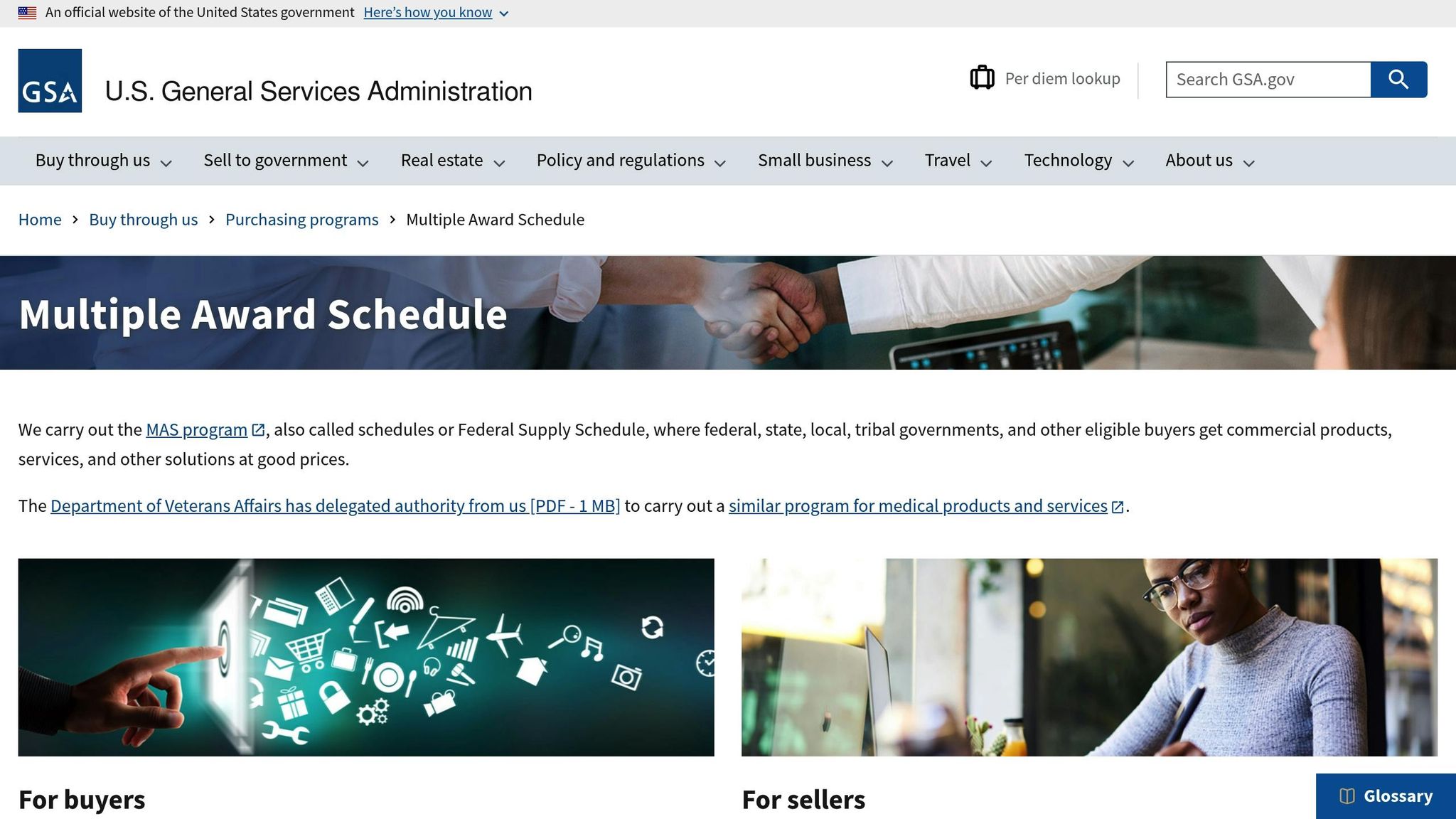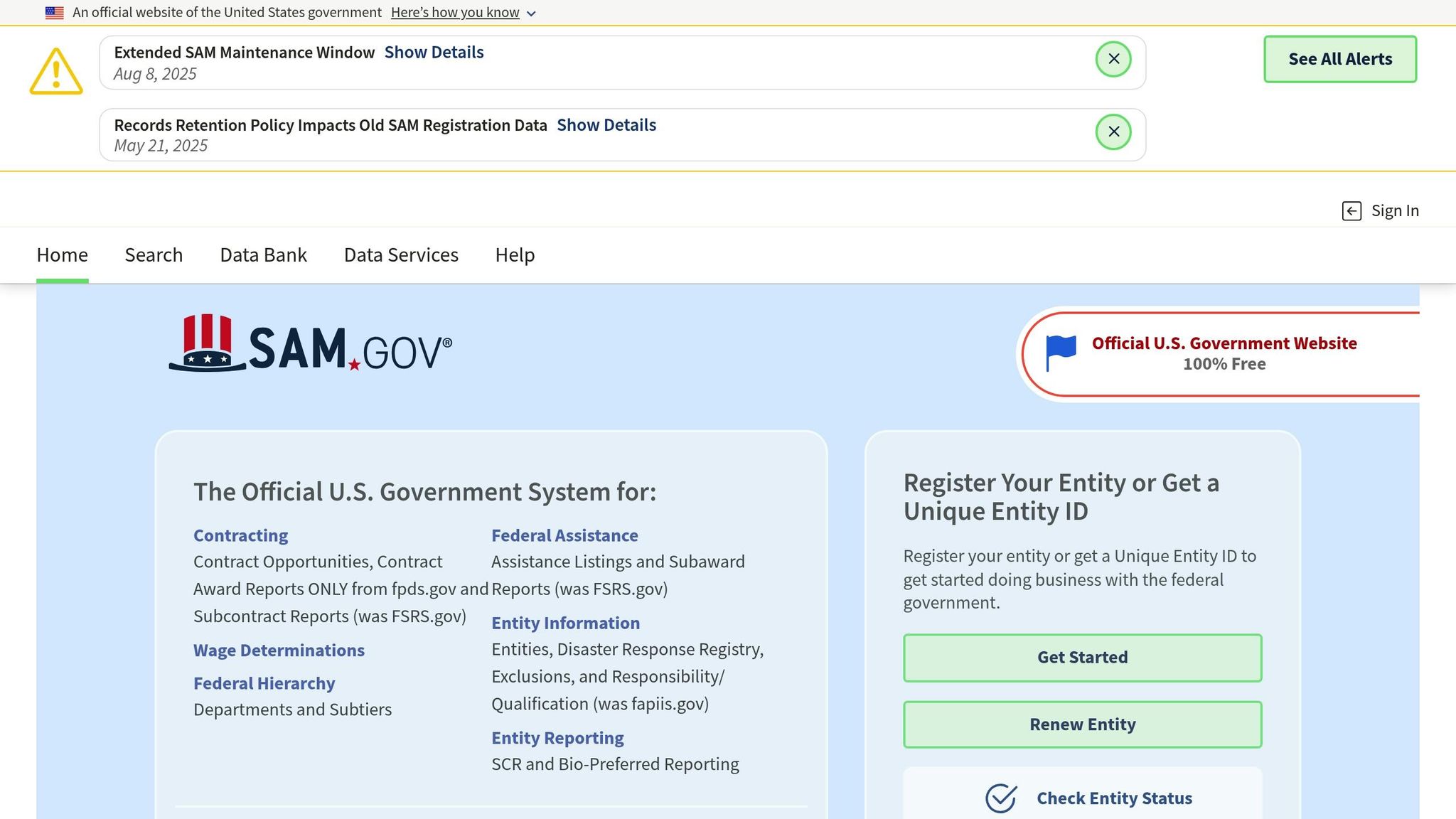The federal government is prioritizing green transportation projects, creating lucrative opportunities for small businesses. With over $570 million already allocated and 20% of contracts now including sustainability clauses, this is your chance to enter a growing market. But winning these contracts requires preparation, compliance, and understanding federal policies.
Key Takeaways:
- Understand Federal Policies: Stay updated on green transportation rules, including recent legislative changes like the "Unleashing American Energy" executive order, which impacts funding and priorities.
- Certifications Matter: Programs like 8(a), HUBZone, and Women-Owned Small Business (WOSB) certifications can give you an edge.
- Prepare Winning Proposals: Highlight measurable outcomes like emissions reduction and energy efficiency. Use case studies to showcase your expertise.
- Get on the GSA Schedule: Register on SAM.gov, assign NAICS codes, and complete the GSA Schedule process to access federal opportunities.
- Track Compliance: Use robust systems to monitor performance metrics, meet reporting standards, and avoid penalties.
By focusing on these steps, small businesses can navigate the federal contracting process and position themselves to win green transportation projects.
Sustainable Procurement A Closer Look at the New Federal Acquisition Regulation FAR
Know Federal Green Transportation Rules
Understanding federal green transportation policies is essential for securing contracts in this evolving space. Recent changes in legislation and executive orders have introduced new priorities and funding structures, making it critical to stay informed. Below, we’ll dive into the key policies and performance metrics that shape eligibility and success in green transportation projects.
Study Federal Green Transportation Policies
Federal policy shifts have a direct impact on green transportation contracting. For example, on January 20, 2025, President Trump signed the "Unleashing American Energy" executive order. This order temporarily paused funding from the Inflation Reduction Act (IRA) and the Infrastructure Investment and Jobs Act (IIJA). It also repealed the non-binding electric vehicle (EV) initiative aimed at achieving 50% new car sales by 2030 and initiated steps to revoke California’s Clean Air Act waiver.
These changes significantly influence contracting opportunities. JoAnne Golden, TRC Senior Vice President, notes:
We’ve seen political shifts and policy changes before – the fact that our landscape is changing is really the only constant. What we see now is a reenergized focus on domestically produced alternative fuels, like renewable natural gas, waste-to-energy solutions, and prioritization of resiliency measures.
Additionally, the U.S. Department of Transportation has introduced revisions to NEPA (National Environmental Policy Act) procedures. These updates enforce uniform deadlines, limit NEPA’s scope to major federal actions, and streamline project approvals. While this speeds up timelines, contractors must meet stricter compliance standards.
Budget changes also play a role. Up to $1.9 billion in unobligated funds from the Low-Carbon Transportation Materials Program has been rescinded, reducing available contracts. Meanwhile, provisions in the budget reconciliation bill H.R. 1 (One Big Beautiful Bill Act) are expected to impact city transportation departments and transit agencies. For small businesses, staying ahead of these developments is key to adapting proposals and aligning with shifting federal priorities.
Learn Performance Measurement Standards
Federal agencies use clear performance metrics to evaluate transportation projects. These metrics help decision-makers assess the effectiveness of proposals and track system performance over time.
The Federal Highway Administration (FHWA) has implemented a standardized approach for measuring greenhouse gas (GHG) emissions. State DOTs and Metropolitan Planning Organizations (MPOs) are now required to set declining carbon dioxide (CO2) targets. As the FHWA explains:
The environmental sustainability, and specifically the carbon footprint, of the transportation system is a critically important attribute that State DOTs can and should use to assess the performance of the Interstate and non-Interstate NHS.
Here are some critical metrics to focus on:
- Emissions reduction: Baseline calculations show that the average vehicle emits one pound of CO2 per mile, while public transit reduces CO2 emissions by 45% compared to driving.
- Energy efficiency: Solutions must minimize carbon emissions without sacrificing operational efficiency, as transportation remains the leading contributor to climate-related emissions in the U.S..
- Real-world actions: For example, Colorado DOT’s 2022 decision to cancel highway widening projects near low-income communities and communities of color highlights how equity and sustainability can influence project decisions.
- Compliance standards: Beyond environmental metrics, proposals must meet Clean Air Act requirements, Disadvantaged Business Enterprise (DBE) standards, and Buy America provisions.
Get Your Business Ready for Federal Contracts
Securing federal contracts in the green transportation sector requires careful preparation, meeting eligibility criteria, and showcasing your business’s strengths. In fiscal year 2019, the federal government awarded $26 billion to women-owned businesses, highlighting the vast opportunities available for small businesses with the right certifications.
Check Small Business Certification Requirements
Federal contracts often prioritize small businesses with specific certifications, offering set-aside opportunities and other advantages. The Small Business Administration (SBA) provides several programs to help businesses compete effectively.
Here are some key certification programs to consider:
- 8(a) Business Development Program: Designed for socially and economically disadvantaged business owners, this program offers training, technical support, and access to exclusive contracts.
- HUBZone Certification: Focuses on small businesses in economically challenged areas, providing access to targeted federal contracts.
- Service-Disabled Veteran-Owned Small Business (SDVOSB) Program: Federal agencies aim to allocate at least 3% of contract awards to businesses owned by service-disabled veterans each fiscal year.
- Women-Owned Small Business (WOSB) Program: The government sets a goal to award at least 5% of federal contracting dollars to women-owned businesses annually.
- Disadvantaged Business Enterprise (DBE) Program: This program ensures fair competition for federally funded transportation contracts among businesses owned by socially and economically disadvantaged individuals.
Certification processes differ based on the program. For instance, some certifications, like Small and Small Disadvantaged Businesses, allow self-certification via SAM.gov. Others – such as 8(a), HUBZone, and WOSB – require formal applications through the SBA. Veteran-owned businesses must certify through the U.S. Department of Veterans Affairs Vets First Verification Program.
Gather Required Documents
To compete for federal contracts, you’ll need to provide clear and detailed documentation that demonstrates your business’s eligibility and capabilities. With increasing emphasis on environmental compliance, having the right paperwork is more important than ever.
Key documents to prepare include:
- Business licenses and permits
- Records of past performance
- Green certifications proving environmental compliance
- Tax returns, financial statements, and insurance proof
- Ownership documentation, including ownership percentages
- Personal financial details for business owners
- Evidence of operations in qualifying areas for location-based certifications
The Green Procurement Compilation (GPC) is a useful resource, offering a list of sustainable products and services as well as guidance on meeting documentation requirements. Federal agencies must also adhere to purchasing rules outlined in the Federal Acquisition Regulation (FAR).
Write Green-Focused Proposals
Your proposals need to highlight how your business supports federal sustainability goals. Successful submissions emphasize the use of clean technologies, eco-friendly materials, and methods that reduce carbon emissions and conserve energy.
Consider these examples to strengthen your proposal:
- Pennsylvania DOT used shredded tires as lightweight embankment fill, recycling approximately 780,000 scrap tires and reducing landfill waste.
- West Virginia State DOT incorporated recycled blast furnace slag in asphalt pavements, improving safety while lowering costs.
Proposals should also address environmental challenges like stormwater runoff from highways or the use of recycled materials in construction. Including conservation practices and ecosystem management strategies can further demonstrate your commitment to greener outcomes.
Federal agencies are required to evaluate environmental impacts for projects requiring high-level approval. Conducting Strategic Environmental Assessments (SEAs) early in the proposal process can help identify and address potential environmental risks.
Once your green-focused proposals are ready, the next step is completing the GSA Schedule process to access these federal opportunities.
Complete the GSA Schedule Process

Building on your federal registration and certification preparations, securing a GSA Schedule Contract is a key step to gaining direct access to green transportation projects. This procurement tool simplifies the purchasing process for government agencies, allowing them to buy your sustainable transportation products and services without the delays of competitive bidding. To get started, you’ll need to register on SAM.gov – a free and essential process for doing business with the federal government.
Register in SAM.gov and Set NAICS Codes

Registering in the System for Award Management (SAM.gov) is the first step in your federal contracting journey. During this process, you’ll assign the appropriate NAICS codes to your business, which are critical for determining your eligibility for green transportation contracts. These codes also help the Small Business Administration (SBA) classify your business size and communicate your expertise to federal agencies, making them essential for qualifying for small business set-asides.
To get started, gather key business details like your DUNS number (or UEI) and a clear description of your company’s primary activities. Identify all relevant NAICS codes and select the one that best reflects your main business focus.
Here’s a quick guide to completing your NAICS code registration:
- Identify your core business activities: Match your operations to the most fitting NAICS code. For green transportation companies, this could include codes related to electric vehicle production, renewable fuel manufacturing, or environmental consulting.
- Verify your choice: Compare your selected code with those used by similar businesses to ensure it accurately represents your operations.
- Update your SAM.gov profile: Log in to your account, go to the "Entity Registration" section, and input or update your NAICS codes in the "Core Data" area.
- Check for consistency: Make sure your codes align with your business description and that all profiles match your SAM.gov registration.
Keep in mind that it can take up to 10 business days for your registration to become active. If you need support, APEX Accelerators offer free assistance. Also, don’t forget to renew your SAM registration annually to maintain your active status.
Once your SAM registration is complete, you’ll be ready to move on to securing expert assistance for your GSA Schedule Contract.
Use GSA Focus for GSA Schedule Support

Navigating the GSA Schedule process can be challenging, but expert guidance makes it manageable. Securing a GSA Schedule Contract involves meeting strict requirements, such as demonstrating financial stability, TAA compliance, and a strong track record of performance. That’s where GSA Focus comes in – they specialize in helping small businesses tackle the complexities of document preparation, compliance, and contract negotiation.
GSA Focus assists with preparing the detailed proposal required by GSA’s standing solicitation. This proposal evaluates your company’s capabilities, financial health, past performance, and pricing. They also ensure you meet key qualifications, such as having your UEI, TIN, and necessary financial documentation in order.
For green transportation companies, meeting TAA compliance is especially important. Products sold through a GSA contract must be manufactured or substantially transformed in a TAA-compliant country. Service providers, on the other hand, need to demonstrate clear labor qualifications, including detailed job descriptions, compensation plans, and quality assurance measures. Additionally, all businesses must adhere to the Most Favored Customer (MFC) pricing principle. GSA Focus also helps with preparing Past Performance Evaluation (PPE) reports, maintaining high CPARS scores, and – for resellers – securing and renewing valid Letters of Supply from manufacturers.
With the help of GSA Focus, you’ll gain access to GSA Advantage, a platform featuring thousands of green products. Federal agencies are encouraged to purchase items like bio-based and recycled content products, as well as those that are Energy Star- and FEMP-qualified, water-efficient, and non-ozone depleting. GSA Focus’s 98% success rate and comprehensive support significantly increase your chances of landing a GSA Schedule Contract for your green transportation business.
Once your GSA Schedule is finalized, you’ll be in a strong position to pursue and secure green transportation contracts with federal agencies.
sbb-itb-8737801
Find and Win Green Transportation Contracts
Securing a GSA Schedule Contract is a big step, but the real challenge lies in finding and winning federal green transportation opportunities. Position your business strategically to stand out in this competitive space.
Search Federal Contract Websites
Start with SAM.gov, your main hub for federal contracting opportunities. This free platform lets you search contracts, save searches, and set up alerts so you’re always in the loop for new opportunities. By using filters like NAICS codes, you can efficiently zero in on green transportation projects. The advanced search options also help you narrow results by agency, contract value, and sustainability requirements.
If you hold a GSA or VA Schedule Contract, GSA eBuy becomes a critical tool. This platform connects you directly to RFQs. Assign someone on your team to monitor eBuy daily and respond quickly to relevant opportunities – it’s a great way to stay competitive.
Don’t stop there. Explore the GSA Subcontracting Directory and SBA Prime Contractor Directory to find subcontracting roles. These directories help you connect with prime contractors who may need your green transportation expertise for larger projects.
Social media platforms like LinkedIn and Twitter can also be surprisingly useful. Many federal agencies announce contracts and initiatives there before they’re officially posted. Staying active on these platforms keeps you ahead of the curve while helping you track industry trends.
Track Market Trends and Opportunities
Understanding market trends is just as important as finding individual contracts. Federal Agency Business Forecasts can give you a sneak peek at opportunities before they’re posted. For example, the DOT Procurement Forecast highlights upcoming transportation-related procurements, allowing you to prepare competitive proposals in advance. Review these forecasts regularly to identify agencies that are heavily investing in green transportation.
Dive deeper into spending trends using your NAICS codes. Research which agencies are focusing on green transportation initiatives and align your efforts accordingly. This targeted approach maximizes your return on investment by directing your resources where they’re most likely to pay off.
For hands-on guidance, turn to Procurement Technical Assistance Centers (PTACs). These centers offer free advice and training to help you navigate the federal contracting world. They can also point you toward regional opportunities that might not pop up in national searches.
Another strategy is to partner with prime contractors who frequently win large federal transportation contracts. Subcontracting with these companies helps you build a track record, making it easier to win prime contracts in the future.
Finally, consider specializing in a niche like EV charging infrastructure or alternative fuels. Federal agencies increasingly value contractors with deep expertise in specific green technologies over generalists. Focusing on a niche can make your business stand out in a crowded field.
Show Your Skills and Build Partnerships
Once your GSA Schedule process is complete, it’s time to shift gears. The focus now is on showcasing your technical expertise and building strong partnerships to win green transportation contracts. Federal agencies aren’t just looking for promises – they’re looking for proof. Demonstrating your ability to deliver on green transportation projects is key to securing contracts that can be worth thousands or even millions of dollars.
Prove Your Technical Skills
To stand out, document your track record with case studies that highlight measurable outcomes. Federal contracting officers want to see clear evidence of success in areas like EV charging, fleet management, and other clean transportation technologies. Share before-and-after data, including metrics like energy savings and CO₂ reductions, to illustrate the environmental impact of your work.
For instance, if you’ve installed EV charging stations, include details like the kilowatt-hours saved, the number of vehicles supported, and the annual reduction in CO₂ emissions. These quantifiable results not only build credibility but also demonstrate the tangible benefits of your solutions.
Highlight long-term savings through lifecycle analysis. Show how your projects reduce maintenance costs, improve energy efficiency, and cut overall expenses over time. Federal agencies value solutions that deliver both environmental and financial benefits.
Consider enhancing your Environmental Management System (EMS) by obtaining ISO 14001 certification. This globally recognized standard underscores your commitment to sustainability and reassures federal agencies of your proactive approach to environmental management.
Make sustainability a central theme in your proposals. From the executive summary to the technical details, weave environmental benefits throughout your narrative. Tailor your proposals to align with each agency’s specific sustainability goals, ensuring your solutions meet their unique needs.
Stay ahead of the curve by keeping up with the latest technologies. Attend industry conferences, earn relevant certifications, and participate in targeted training programs. This ongoing education allows you to confidently discuss emerging trends during proposal meetings and contract negotiations.
Partner with Industry Companies
In addition to proving your technical expertise, forming strong industry partnerships can significantly enhance your competitive edge. Collaborate with manufacturers, service providers, and other key players in the clean transportation sector to expand your capabilities. These partnerships enable you to tackle larger, more complex projects while strengthening your sustainability credentials.
Seek out partners who share your commitment to sustainability and bring complementary skills to the table. Research their track records in environmental initiatives and assess their reputations. Successful collaborations often stem from shared values and diverse technical strengths.
Take a team-based approach when evaluating potential partnerships. Involve leadership, legal, finance, procurement, and marketing teams to ensure alignment on goals and capabilities. This cross-functional perspective helps identify potential challenges early and ensures a smooth collaboration process.
Think beyond traditional contractor relationships. Explore partnerships with research institutions, environmental nonprofits, or innovative startups offering fresh solutions to green transportation challenges. These unconventional collaborations can make your proposals stand out and emphasize your dedication to cutting-edge sustainability practices.
Clear communication is essential when forming partnerships. Discuss how resources, expertise, and responsibilities will be shared, and establish agreements covering intellectual property, revenue sharing, and performance standards. Transparency and alignment from the start set the stage for successful partnerships.
Focus on partnerships that bring together diverse perspectives and expertise. Combining different technical backgrounds and sustainability approaches often leads to creative solutions for complex challenges, helping your team stand out in the federal contracting landscape.
Document these partnerships in your capability statements and marketing materials. Federal agencies want assurance that you have reliable relationships with trusted partners who can support large-scale green transportation projects. Include details like certifications, past collaborative successes, and the combined strengths of your team.
With sustainability clauses now included in over 20% of federal contracts – and this number expected to grow – your technical expertise and strategic partnerships put you in a strong position to tap into this expanding market while advancing federal environmental goals.
Stay Compliant and Prepare for Reviews
Securing a green transportation contract is just the beginning. Federal agencies require contractors to uphold strict compliance standards throughout the contract’s duration, with regular audits to ensure adherence. Falling short on compliance can lead to penalties, losing the contract, or even being barred from future bids – not to mention the damage it can do to your reputation.
"In government contracting, compliance is non-negotiable. Regular audits and reviews ensure that contractors meet strict regulations and standards. Failure to comply can result in penalties or lost contracts." – GovBiz Weekly
Federal agencies are tasked with ensuring that 95% of new contract actions involve products meeting rigorous environmental standards. These include energy and water efficiency, biobased materials, and non-ozone-depleting properties, among others. This means your green transportation projects will be closely examined for their environmental performance.
Set Up Compliance Tracking Systems
Understanding the stakes of compliance is one thing; setting up systems to stay on top of it is another. To meet federal expectations, you’ll need robust tracking systems that monitor every detail of your contract performance. These systems should capture metrics like carbon emissions reductions, energy efficiency improvements, and cost savings. Federal agencies may also require detailed reports on items purchased and their costs to ensure compliance with purchasing requirements.
Environmental performance metrics are especially critical. For instance, if your project involves installing EV charging stations, track data such as kilowatt-hours delivered, vehicles served, and CO₂ emissions avoided each month. For fleet electrification, document fuel savings, maintenance cost reductions, and operational efficiency improvements. These details not only demonstrate your project’s impact but also reinforce your commitment to sustainability.
For cybersecurity, make sure you’re using tools that align with federal standards like the Cybersecurity Maturity Model Certification (CMMC). Regular internal audits are essential to identify and address compliance gaps before federal reviewers do. Quarterly reviews of your tracking systems, documentation, and performance metrics can help you stay ahead of potential issues and show your dedication to meeting federal standards.
Additionally, ensure your team is well-versed in Federal Acquisition Regulation (FAR) guidelines and any agency-specific rules. Ongoing training should cover cost accounting, environmental reporting, and proper documentation practices.
Keep Complete Records for Audits
When it comes to audits, comprehensive documentation is non-negotiable. Federal auditors expect detailed records covering every aspect of your contract performance, from correspondence and modifications to financial transactions and reports.
Your document retention policies must align with federal requirements, as losing critical records can lead to compliance violations. Using cloud-based software can help you keep audit-ready records organized and accessible.
"Compliance policies show a government contractor’s corporate commitment to following federal and state and local government rules. They demonstrate consistency in how a government business and its staff behave and can lower risk of exposure." – Jody Twining, Senior Marketing Manager, Deltek
Maintain detailed communication logs for every interaction with federal personnel. Record phone calls, emails, meetings, and informal conversations, noting dates, participants, topics, and decisions made. For green transportation projects, your performance documentation should include environmental impact data, cost-benefit analyses, and progress toward sustainability goals. Enhance these records with photos, technical specs, installation reports, and user feedback.
Every expense must adhere to FAR guidelines, meaning costs should be reasonable, allocable, and directly tied to specific contract deliverables. Federal auditors will scrutinize these details, so ensuring accuracy is crucial.
Appoint an audit liaison within your organization to handle communications with federal auditors and provide requested documents promptly. Tools like Asana can streamline audit preparation tasks, while software like AuditTracker can help manage auditor communications and track document requests.
Finally, conduct follow-up reviews within three to six months to confirm that any corrective actions have been implemented. This proactive approach not only resolves issues but also demonstrates a commitment to continuous improvement.
"Maintaining compliance in federal contracting is essential to avoid penalties, secure contracts, and build a reputable business." – USFCR
Federal agencies spending over $10,000 on designated items are required to establish procurement programs that prioritize recovered materials and biobased products. These programs also promote the use of such materials and verify compliance with usage standards. By keeping meticulous records and maintaining strict compliance, you can position your business for long-term success in federal contracting.
Key Steps for Success
Securing green transportation contracts isn’t just about submitting a bid – it’s about adopting a well-rounded strategy that blends preparation, compliance, and expert insights. With nearly 12,000 small businesses on GSA Schedules averaging over $1.1 million in annual sales, the opportunities are significant.
Start with the basics. A solid understanding of federal green transportation policies and performance standards is the backbone of any successful contracting strategy. Small businesses that take the time to familiarize themselves with the Federal Acquisition Regulation (FAR) and agency-specific environmental requirements gain a competitive edge. Once you’ve mastered these fundamentals, it’s time to align your operations with sustainability goals.
Make Environmental Management Systems (EMS) a priority. Don’t treat environmental compliance as an afterthought. Build tracking and management systems into your operations from the outset. As the Federal Transit Administration explains:
An EMS is a set of processes and practices that enables an organization to reduce its environmental impacts and increase operating efficiency.
These systems not only reduce environmental footprints but also provide measurable results that resonate with federal agencies.
Leverage expert guidance for the GSA Schedule process. Navigating the GSA Schedule can feel daunting for small businesses due to its intricate requirements. Partnering with specialized consultants, such as GSA Focus, can simplify the process. From document preparation to contract negotiation, these experts help reduce compliance risks and administrative headaches. Once your proposal is in place, ensure you have internal systems to track and maintain performance.
Implement robust compliance tracking. Federal contracts come with strict compliance expectations, including regular audits. Create clear action plans to address potential gaps, track adherence to environmental commitments, and document oversight activities. A proactive approach minimizes risks like penalties or contract termination while enhancing your reputation for dependability.
Highlight measurable environmental outcomes. Federal agencies want to see results. Track and report specific metrics, such as reductions in carbon emissions, improvements in energy efficiency, or cost savings. Demonstrating tangible benefits strengthens your case and underscores your commitment to sustainability.
With federal agencies increasingly prioritizing environmental standards, the green transportation market is expanding rapidly. Success in this space requires more than just meeting requirements – it’s about excelling through preparation, execution, and leveraging expert support. By mastering the essentials, building strong compliance systems, and focusing on measurable impact, small businesses can position themselves as leaders in the federal contracting arena.
FAQs
What federal policies influence green transportation contracts, and how can businesses stay informed about changes?
Federal policies are a driving force behind opportunities in green transportation contracts. Recent trends highlight a growing emphasis on incentives for renewable energy and electric vehicles, alongside funding priorities from the Department of Transportation (DOT) that center on sustainability, climate initiatives, and equity.
For businesses aiming to stay ahead, keeping tabs on updates from the DOT and other federal agencies is crucial. Subscribe to official newsletters, review grant guidance, and track policy announcements to ensure your business stays aligned with the latest regulations and funding programs.
How can small businesses use certifications like 8(a), HUBZone, and WOSB to secure green transportation contracts?
Small businesses can tap into certifications like 8(a), HUBZone, and WOSB to gain access to exclusive contracting opportunities. These include set-asides and price evaluation preferences specifically designated for certified firms. Such programs aim to create a fairer environment, making it easier for smaller businesses to compete for contracts in areas like sustainable transportation.
Beyond contracts, these certifications open doors to valuable resources like mentorship programs, networking events, and specialized tools that can enhance a company’s visibility and reputation with federal agencies. Holding multiple certifications can be even more advantageous, as many contracts favor businesses with a combination of qualifications. By capitalizing on these opportunities, small businesses can carve out a stronger position for themselves in the expanding green transportation industry.
What steps should small businesses follow to meet federal standards for green transportation projects?
To meet federal guidelines for eco-friendly transportation projects, small businesses need to start by familiarizing themselves with key environmental regulations, such as the National Environmental Policy Act (NEPA). This means understanding the requirements for environmental assessments and securing the necessary approvals.
From there, businesses should align their initiatives with federal objectives aimed at cutting greenhouse gas emissions and advancing sustainable transportation. This could include adopting energy-efficient technologies, selecting environmentally friendly materials, or following decarbonization strategies recommended by federal agencies.
Lastly, it’s crucial to ensure that all documentation and permits are completed accurately and submitted on time. Staying organized and proactive in meeting these compliance standards is critical to keeping projects on track and avoiding delays.
Related posts
- Key Terms in GSA Contracts Explained
- How to Access GSA Small Business Support Programs
- Federal Contract Award Lifecycle Explained
- How GSA Contracts Support Infrastructure Upgrades


